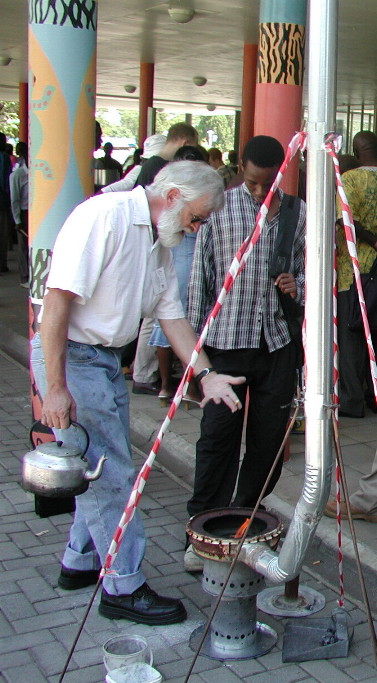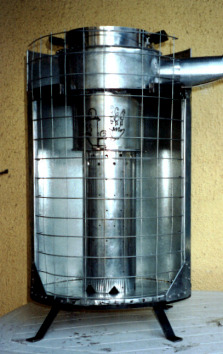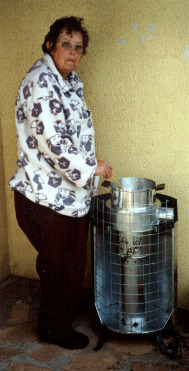



GASIFIER COAL STOVE
John Davies, South Africa April 2003, New Photos October 2003
 |
 |
| Kettle simmering. No visible smoke (April 2003) | Top lit Demo (April 2003) |
 |
 |
| With Reflective Stand and safety Guard (October 2003) | (October 2003) |
OCTOBER 2003
I attach a couple of photos of a newer model of my coal stove, which has been put into a reflective stand with safety guard. This model has been under test in my home during the winter and met most expectations. The stand might make it too expensive for the poorest, but I am working on a simple stand to allow a cheaper version. I am also working on a couple of changes to make it more user friendly. However the combustion design remains basically unchanged.
Regards,
John Davies,
Secunda, South Africa
BACKGROUND.
The gasification of coal has been commercially exploited for more than 100 years. One of the early applications was the production of “COAL GAS” for the cities in first world countries during the nineteenth century. Later applications were used in the chemical industry for the manufacture of a host of chemicals and synthetic fuels.
In 1956 the Argentinean steam locomotive engineer Dr L D Porta successfully applied this process to a fleet of small railway locomotives, where the gas production and the combustion of the resultant flammable gas took place in the firebox of the coal fuelled
locomotives. This advanced the steam locomotive in respect of efficiency, power and reduced air pollution.
The use of coal for domestic cooking and heating is practised in many parts of the world, by people of the lowest income groups, living in informal housing, in the highest population density areas.
During the winters on the South African “highveld”, a low inversion layer coupled with the most inefficient burning methods leads to extreme air pollution of these areas, with the resultant poor visibility and health problems. While the authorities have brought electricity to these communities, the preferred method of heating in these areas remains the burning of low grade bituminous coal. in a brazier. This is apparently a much cheaper alternative. A small, simple gasifier coal stove has been developed.
WHY THIS STOVE IS NEEDED.
Apart from the traditional combustion methods being very energy inefficient, the volatiles and much of the carbon is flared off under conditions of incomplete combustion, out of doors, resulting in heavy acrid smoke due to partially burned products of the bitumen, and carbon being expelled into the air. During this stage the cook of the house is exposed to high concentrations of unhealthy pollutants.
The resultant hot coke embers are carried into the house to burn further and heat the house. This results in a rapid increase of Carbon Monoxide in the air due to the poor combustion of the coke. Ventilation of the house is achieved by partially opening of a window, the required ventilation being judged by the relative sleepiness of the inhabitants.
Many deaths are recorded each year due to Carbon monoxide poisoning.
THE STOVE.
Comprizes of three components:
Combustion Unit.
This unit uses controlled pyrolysis of the coal and combustion of the resultant coke in order to obtain a fairly constant heat output from initial lighting until the coke is
exhausted. Virtually smoke free operation is achieved from lighting until the end of the burn.
Cooking unit.
A single pot-holder unit is supplied with the stove, but additional heat utilizing units can be added.
Chimney
This is also supplied as it forms an essential part of the stove, creating the conditions required for good combustion. This allows the stove to be used indoors.
COAL CHARGING.
The stove must be loaded with the required coal charge before lighting. To extend the burning time after lighting, coke may be added in small quantities towards the end of the burn. Coke may be obtained when the burn time exceeds the requirements, by emptying out the unburned coke and extinguishing it, and storing for the future.
ADVANTAGES
1. Coal savings can exceed 50%.
2. Cooking heat is attained immediately after lighting.
3. Air pollution of area greatly reduced.
4. No indoor air pollution.
5. Cooks comfort greatly increased.
6 Heat output can be regulated
7 Coal capicity from 250g to 3 Kg.
8 Combustion period between 1 and 5 hours.
9 Designed to give direct heat radiation to the house when used as a space heater.
MATERIALS.
Heat withstanding metal is used in all parts in contact with the hot coal and flames.
COST
The estimated selling price is about R300 ( about $30 US ).
The cost should be recovered by coal savings over a period of 12 to 18 months.
STOVE LIFE.
This is expected to exceed the pay back period due on coal savings.
PROJECT STATUS.
A demonstration model exists. This model is in the final stages of tuning. A small quantity will be manufactured shortly for evaluation by members of the community.
John Davies.
P O Box 2342
Secunda,
2302
South Africa.
Phone 27 - 017 634 1909
e-mail mailto:jmdavies@telkomsa.net
Phone +27 017 6341909
January 2003
Rev March 2004